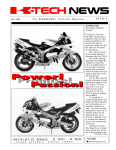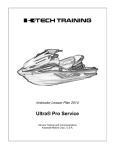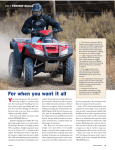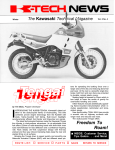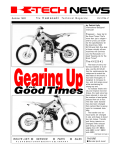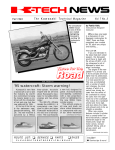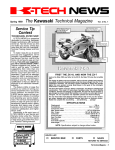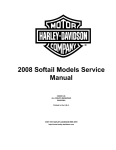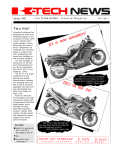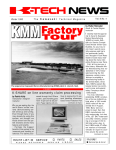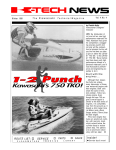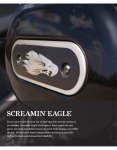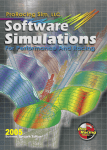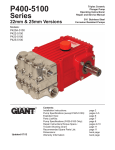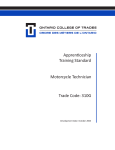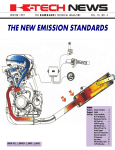Download K-Tech News Vol.5 No.3
Transcript
Fall 1992 The Kawasaki Technical Magazine Vol. 5 No. 3 by Patrick Kelly Instructional Designer, Instructor Where do we start when describing Kawasaki’s latest off-road wonder? This new machine is so innovative it’s hard to pick one item that is more important than another. From its all new engine to its stateof-the-art perimeter frame to its sophisticated suspension, the new KLX650-A1 has it all. And let’s not forget about its equally sophisticated street legal brother, the KLX650-C1. Since it has the same 100mm bore and the same 83mm stroke for a displacement of 651cc, some people may pre-conceive the new KLX engine as simply an updated KLR 650 engine. However, nothing could be further from the truth since many new design features put this engine in a different class. This new engine is more compact in all dimensions, being 13mm narrower side to side and 30mm shorter front to back. And, while the torque CONTINUED ON PAGE 2 ROUTE LIST: o SERVICE P L E A S E R E T U R NT O o PARTS S E R V I C E o SALES L I B R A R Y Inside! n Service tips & more! KLX650 CONTINUED FROM PAGE 1 output of the KLX650-A engine is up 13 percent, its weight is down over 20 percent when compared with the KLR650 engine. with outer shims, the same as used on the KL650-A/B, to open the valves while dual springs close the valves. The cams are driven by Kawasaki’s unique dual-stage cam-drive system, similar der but also transfers heat more efficiently. The more efficient heat transfer allows the piston to cylinder clearance to be tightened as well. The bottom end of the KLX engine is also all completes the KLX650-Al powerplant. It incorporates a rev limiter to cut the ignition intermittently at 8500 rpm and completely at 9000 rpm, preventing damage from overrevving. The new KLX650 engine (LEFT) is “‘in a different class” from the familiar KLR650 unit (RIGHT). Over an inch shorter and half-an-inch narrower, it weighs 20 percent less and produces 13 percent more torque! The massive cylinder breathes through two large 38mm intake valves. These valves are fed by a 40mm semi-flat slide Keihin CV carburetor, which features a coasting enrichener system to prevent backfiring during engine braking by supplying a rich fuel mixture to the engine. The carburetor is fed by an extra large airbox for crisp throttle response. Air enters this large airbox from under the front of the fuel tank. This system, the Fresh Air Intake System (FAIS), helps reduce maintenance and keeps performance up in dusty and wet conditions. The exhaust gasses exit the cylinder through two 33mm exhaust valves into a stainless steel exhaust pipe. Dual overhead cams act directly on the buckets 2 l K-Tech News to the system used on the VN750. Dual-stage cam drive allows the top of the engine to be more compact, and also allows the camshafts to be closer together for an included valve angle of a mere 20°. This extra-narrow included valve angle allows the use of a pentroof type combustion chamber for excellent surface-to-volume ratio and exceptional thermal efficiency. This combustion chamber combines with a concave piston crown to provide a 9.5:1 compression ratio. One of the most exceptional features of the KLX650-A, and a first for any production four-stroke Kawasaki, is its electrofusion cylinder. The electrofusion cylinder not only saves 2 Ibs. over a conventional wet-lined cylin- new. It features a single counter-balancer to help cancel out engine vibrations. Compared to the KL650A/B’s dual counterbalancer, the single balancer has a lighter moment of inertia for quicker revving and acceleration. The crankshaft also has a lighter moment of inertia because the flywheels are the half-circle type as compared to the KL650A/B’s full-circle type. In addition, the crankpin diameter has been reduced to limit power- robbing friction. Dual oil pumps also do their part to reduce parasitic power losses. One pump scavenges the sump to prevent the crankshaft and magneto from rotating in a bath of oil while the other supplies fresh oil to vital engine parts. A digital CD ignition The chassis on the new KLX650 has been designed to the same high standards as Kawasaki’s KX line. Topping the list is a box-section steel perimeter frame. This frame gives the KLX excellent rigidity for superior handling characteristics combined with superior mass centralization. The front forks are inverted, with 43mm inner tubes and 16-way compression damping adjustment. They provide 11.8 inches of plush frontwheel travel. The Uni-Trak rear suspension utilizes a nitrogencharged piggyback reservoir shock with 16way compression-damping adjustment and 16-way rebound-damping adjustment. This sophisticated shock is combined with an aluminum swingarm to provide 11 in. of rising-rate rear-wheel travel. Braking chores are handled by front and rear disc brakes. A floating front disc, the same as used on the KX125/250/500, is combined with a twin-piston caliper in the front while a rear disc with single-piston caliper takes care of the back. Twenty-one-inch front and 18 in. rear aluminum wheels with straight-pull spokes complete this allnew off-road powerhouse. Dual-purpose enthusiasts will be pleased to know there is a streetlegal version of the bike described above: the KLX650-C1. It’s made to the same exact standards, but with some changes to make it more street compatible. The KLX650-C engine has slightly less intake cam duration for more lowend and mid-range torque. This combines with more flywheel mass to smooth out the power delivery and provide a stable idle. The electrofusion cylinder is replaced with a conventional wet-lined cylinder. This, along with a larger capacity silencer, helps to lower the noise level to street-legal levels. The KLX650-A’s aluminum kick starter is replaced with a electric starter to make starting an effortless task while a thermostat and electric cooling fan are added to the cooling system to keep the engine’s operating temperature stable at all times. To better suit the wider range of speeds deman- ded of the KLX650-C, the transmission gear and final drive ratios are changed. Although the frames are very similar except for brackets and gussets, the wheelbase of the KLX650C is extended 22mm, and the rake is changed from 27° to 28.5° for improved straight-line stability. Because the suspension will not be stressed as much and to help keep things simple, the front and rear suspensions do not have adjustable damping force. Front wheel travel is 11.2 in. and rear wheel travel is 10.2 in., helping to lower seat height 2.6 in. from the “A” model. The front brake disc is increased in size by 40mm to 290mm to increase stopping power and heat capacity of the front brake. The rear brake is unchanged. Other changes to make the KLX650-C more compatible with street use are a locking fuel tank cap, tool kit mounted next to the rear shock, maintenance-free 8 AH battery, speedometer and tachometer, temperature warning light, O-ring drive chain and handlebarmounted end weights to dampen vibration. With the introduction of the KLX650-A1 and KLX650-C1, Kawasaki has raised the stakes in the big bore off-road and dual-purpose classes. And the competition is about to find out that we’re not bluffing! o (LEFT) Front forks on the KLX650-A are inverted, feature 16-way compression damping adjustment and provide nearly 12” of front-wheel travel. (BELOW) 650-C engine has more low-end and midrange torque and a conventional wet-lined cylinder. Larger side cover houses the electric starter. (RIGHT) Modern instrument cluster on the new KLX650-C is a real eye-catcher. The Technical Magazine 3 l Fall 1992 Vol. 5 No. 3 ©1992 Kawasaki Motors Corp., U.S.A. (KMC). All rights reserved. K-Tech News Staff Publisher Kawasaki Tech Services Challenge your service IQ —and win new tools too! by Fred DeHart Technical Services Instructor Kawasaki will begin a Publications Manager Don Church Executive Editor Gary Herzog Editor-in-Chief Gregg Thompson Communications Editor Patrick Kelly Regional Editors North and East Fred DeHart Central and South Walter Rainwater Contributors Dave Behlings, Jerry Heil, Keith Pestotnik, John Porno, David Pyle, Steve Rice, Ray St. John, Sharon Willeke Graphics/Production Graphic Art Gregg Thompson Copy Editor Pat Shibata Production Nickless Communications Published by Kawasaki. All suggestions become the property of KMC. Sending a service suggestion gives Kawasaki permission to publish and/or use it without further consideration. Specifications subject to change without notice. 4 l K-Tech News new Service Contest with the next edition of K-Tech News! Three tests will arrive at your dealership via the next three issues. Each test will consist of 100 multiple choice questions. Don’t know the answer? Look it up in your service Micro- materials-this is an open book test! Scoring an 85 or better on any of the three tests will get you a prize. A grand prize will be awarded to the highest overall scoring contestant that completes all three tests. This contest is open to all full-line dealership service personnel. It’s a chance to test your service knowledge, learn while you search for answers, and win some extra tools for your own tool box! No matter what you score, you come out the winner by increasing your knowledge as you take the test. So accept the challenge: Enter the Kawasaki Service Contest. Look for contest rules and the first test in the next issue of K-Tech News. o : ABCs, VlNs and RFCs by David Pyle Parts Publications Specialist L ately I have received many calls regarding painted parts and decals. There’s no question that looking up part numbers for painted parts can be confusing. To make matters worse, many times your customers remember the year they purchased the vehicle not the actual model year. Ordering the wrong part causes many problems. There’s the extra time spent re-ordering the part, filling out the RFC and restocking, and there are additional charges. And meanwhile your customer is waiting for the correct parts. The best way to eliminate these headaches is to verify the VIN numbers on the customer’s machine. The VIN number information can be found on every microfiche on Grid A-l, and also on the Model ID Grids on the A-row on every fiche card. After verifying the model year with the VIN number, pay close attention to the reference number specifications code and year and model column. Taking a few extra minutes before (and while) ordering will save you more time in the long run—and you’ll have a happier customer, too. o Vulcan™ 700/750 hard starting and misfiring by Keith Pestotnik Rocky Mountain Kawasaki Complaints of random hard starting, poor idling, poor throttle response, misfires, and sometimes carburetor backfire or exhaust afterfire on Vulcan™ 700 and 750 models can often be eliminated or reduced by reducing the pickup coil air gap. The pickup coils are mounted on the left hand side of the engine behind the outer alternator cover. The air gap from the factory is set at 1.0mm and is not adjustable because of small cast bumps on the mounting screw bosses that hold the coils in place. You can make this gap adjustable, however, by taking the coils off the mounting plate and then knocking off these little locating tabs. Put a dab of grease on a small sharp chisel and just shear them right off. Now, install the coils with a 0.5mm gap instead of the standard 1.0mm gap. This modification has been approved by the manufacturer and is not considered tampering (emissions). It’s fairly easy to do and is worth trying for just about any starting or low-speed running problem on the Vulcan 700/750 series. Don’t bother with this modification if you are not trying to solve a problem; it doesn’t increase performance in any way. o TECHNICALITIES “Dualing” drain plugs The ZR1100 engine looks a lot like the old KZ1100 engines on the outside, but there's one important difference you should know before you do a service on one: As in the 900, 1000, and 1100 Ninja® engines, the ZR1100 engine has a dual oil pump, two oil sumps and ... that's right, two drain plugs! One is in the RH side of the oil pan below the primary gear facing down, and the other is in the deeper main sump below the transmission facing forward. Don't forget this when you do your next oil change on the Big ZR. - Gregg Thompson Crankshaft bearings: Speeding up the repair process ... When replacing a fourstroke crankshaft, you have to select the proper bearings according to the markings on the crankshaft, crankcase, and connecting rods. There are three sizes of “standard” bearings to accommodate close production tolerances. In each model’s service manual, there are charts that help you select the proper bearing for each journal according to the marks. Because you can’t order these parts by size, you won’t know what size bearings to order until you have opened the box and examined the new crankshaft, cases, and/or rods, adding considerable time to the repair process. The bearing selection process also holds true for some engine balancer shafts. To prevent these delays in the parts order/repair process, you can now order all bearing sizes (three complete sets), use the bearings you need and return the unopened and unused bearings to the distribution center. Put on the “Return for Credit” form that you need to return the unused bearings ordered for a crankshaft repair. There will be no restocking fee in these situations. - Walter Rainwater The Technical Magazine 5 l 750 ignition tests by Fred DeHart Technical Services Instructor Have a 750 JET SKI® with no spark? Here are a few quick checks to help you find the problem quickly and easily. You can use your multimeter and, if you have one, the old Kawasaki CDI tester. Test I: Output from the pick-up coil 1. Disconnect the 4-pin connector coming from the magneto. 2. Connect the multimeter or tester leads to the green and the blue wires. 3. Set the multimeter to the 10 AC volt scale or the tester to low 15. 4. Crank the engine over with the spark plugs removed. 5. Voltage output should be about 0.5 VAC. Test II: Output from the exciter coil 1. Disconnect the 4-pin connector coming from the magneto. 2. Connect the multimeter or tester leads to the purple and the red wires. 6 l K-Tech News 3. Set the meter to the 250 AC volt scale or the tester to high 30. 4. Crank the engine with the spark plugs removed. 5. Voltage output should be about 75 VAC. Test Ill: Output from the CDI unit to the ignition coil (Note: For this test, you must use the Kawasaki CDI tester) 1. Disconnect the orange and the black/white wires from the ignition coil and connect the tester leads to them, paying attention to polarity. Connect the load coil (that comes with the tester) to the leads also. Leave the magneto wires connected. 2. Set the tester on high 60. 3. Crank the engine with the spark plugs removed. Be sure to disconnect the stop switch wires and check for spark before beginning the tests. If these tests do not indicate the source of the problem then additional troubleshooting of the ignition coil and wiring will be required. o Impellers: Do they need ... E very now and then, the Hot Line will receive a call from a dealer who is baffled by the fact that a 650 JET SKI® pump impeller has come right off the threads of the pump shaft and chewed itself up along with the housing. The most common question is, “Doesn’t it tighten itself onto the shaft while it’s running?” Technically it does, but on the 550-B and -C, 650, and 750 models, the torque that is applied to the threads by running it in the water is very, very slight. On the older style pumps (including all 440s and 300s) all the torque it takes to turn the impeller in the water (and that’s a lot!) is transferred to the impeller through the threads because the impeller is threaded right onto the driveshaft. The driveshaft turns, the impeller resists, the threads get tight. On the 550-A models, the impeller is threaded onto the pump shaft instead of the driveshaft, but the driveshaft turns the pump shaft which turns the impeller (LH thread), the impeller resists ... and, yes, the threads get tight. ® JET SKI 750SX watercraft: Don’t overrev ’em! by Gregg Thompson Sr. Product Support Specialist We have had many calls on the Hot Line about the new JET SKI® 750SX where the flywheel bolt has come loose or the oil pump shaft has broken inside the pump body. Believe it or not, we think both these failures can be caused by one thing: overrevving the engine. The way the oil pump shaft is shearing inside the pump body indicates it is simply being subjected to too much torque. That torque is also applied in the direction that would unscrew the flywheel bolt. But the torque needed to shear the oil pump shaft or loosen the flywheel bolt can only be created at revs well above the normal operating range of this engine. The ignition system has a rev limiter to prevent ... overrevving, but it is not operational for about the first minute after start-up. It is during this first minute that we believe the damage is occurring. Many people (especially people involved with motocross) are used to starting a twostroke engine, holding the throttle wide open for a few seconds and then “blipping” the throttle at high rpm for a short while to “clear out the engine.” This procedure doesn’t normally cause any damage to a single cylinder two-stroke engine since they won’t free-rev fast enough to hurt the internal engine parts. But spinning a positive displacement oil pump at 9000 rpm is another story! Kawasaki has made a new flywheel bolt available (P/N 92150-3813) which can be torqued to 94 ft/lb instead of 72 ft/lb (the torque value for the original bolt). Installing this new bolt at the higher torque spec. should prevent the bolt loosening, but it cannot prevent overstressing the oil pump shaft when the engine is overrewed. So educate your customers not to rev the engine very high when the boat is out of the water-and not to ride the vehicle at wide open throttle for the first minute after each startup! (Actually, the engine will not overrev as long as the pump is in the water, but if the customer takes off at WOT (or WFO, depending upon what sport you come from!) and 100 yards out jumps a goodsize wake without letting off, he/she could easily spin the engine beyond its safe rpm range.) Bad habits are hard to break-start telling your customers today. o to be torqued? On the pumps used in the 550-B and -C, 650, and 750 models, the impeller is threaded onto the pump shaft like the 550A. But in these pumps, the driveshaft drives the impeller directly through splines inside the impeller. The pump shaft just kind of goes along for the ride. The only torque applied to the threads is what it takes for the impeller to drive that little pump shaft. All the torque it takes to drive the boat is carried by the splines. You will notice in the service manuals for the various 550, 650 and 750 models that the torque value given for the impeller is 72 ft/lb. Whenever you are installing an impeller on one of these watercraft, make sure you use a torque wrench. It’s pretty tough to apply 72 ft/lb with your handy adjustable crescent. You will also need an impeller wrench to do this job—P/N 57001-1228 or you can make one: Just cut the splined end off of an old 650 driveshaft and braze a half-inch-drive socket to it. - Gregg Thompson The Technical Magazine l 7 Watercraft test tank ... ready-made by Gregg Thompson Sr. Product Support Specialist Several times in the past we have published information to help you build your own watercraft test tank. However, we realize that building your own test tank can be both time-consuming and expensive, and in most cases the final product is a permanent fixture: Where you build it is where it stays. Recently, I had an opportunity to take a look at a ready-made test tank manufactured by a small, Southern California-based company called Bresee Manufacturing. This very compact all steel tank has a water surface large enough (5 ft. x 11.5 ft.) to accommodate personal watercraft as large as our 650 “SC” Sport Cruiser. It is designed so that the outside dimensions are not much larger than the useable water surface. The tank comes with a davit for loading and unloading, and a thrust gauge as standard equipment. An electric hoist is optional as is a pump and 8 l K-Tech News filtration system. Test tank water gets very murky very quickly, so this filtration system is a welcome addition. I had a chance to observe this tank in use at a local dealer and, in my opinion, it works exceptionally well. It handles the pump wash so effectively that virtually no water splashes out of the tank during use. And clean, smooth water is always delivered to the pump from the front so “cavitation” from air in the water is not a problem. We at Kawasaki have al ways strongly recommended the installation and use of personal watercraft test tanks by our dealers, but this is the first time we have been able to recommend a finished product that you can purchase ready-to-use. For more technical infor mation plus prices and availability, contact the manufacturer directly: Bresee Manufacturing 14302 Plantana Dr. La Mirada, CA 90638 (310) 944-7339 TECHNICALITIES As JS300 model JET SKl® watercraft begin to age, we get more calls concerning what seems to be slipping starter motors. The starter motor runs, but the crankshaft and driveshaft are turning intermittently or not at all. Look for the solution to this problem inside the gear case on the rear of the engine. The first area of concern is the one-way clutch which is pressed onto the crankshaft taper by the drive shaft coupler. Remove the clutch and inspect both races and the rollers in the sprague assembly for wear. Any visible wear on the races or rollers can cause it to slip, and the worn parts must be replaced. Next, inspect the tapers on the crankshaft axle and inside the large clutch piece (called the “race” in our technical publications). If there are signs of slippage, the two tapers must be lapped together to ensure a proper fit. Lap them until both tapers are making good contact their full length all the way around. To confirm the fit, clean the parts and then tap the race onto the crank with your hand. The tapers should grip and be very difficult to separate by hand. Next, inspect the reduction gear. On 1986 and 1987 models, this appears to be a one piece assembly. It is actually two separate gears pressed onto the shaft. Test it by clamping one gear in the soft jaws of a vise, and trying to turn the other gear with large slot-jaw pliers. (Be careful not to damage a good gear.) Any movement in either direction between the gears means its time for a new one. On 1988 and later models, the reduction gear incorporates a torque limiter to increase durability. This part does not directly interchange with the earlier part. It works well, but can also be overworked from hard starting engines and modified compression ratios. Don’t forget to torque the driveshaft coupler to 72 ftIbs. during reassembly. If you don’t, the one-way clutch will slip on the taper again. - Keith Pestotnik Hot Tip: A cool way to install bearings by Steve Rice Product Support Specialist When installing ball bearings into a vertically split crankcase or onto a crankshaft, things can get a little tight. It’s supposed to be that way: The bearings are designed to have an interference fit in the cases and on the crank axle. But just pounding on the parts harder to get the bearings all the way installed is not real good for them. So, how do you get the parts together without beating on them? Well, you could make the outside part bigger and the inside part smaller! That’s a simple solution and, luckily, the procedure itself is almost as simple. When installing a bearing in the crankcase half, put the bearing in the freezer long enough for it to get real cold. Then, heat the cases to about 200° F. (If there’s a seal there, be careful not to overheat it.) When aligned with the bore properly, the frozen bearing should just drop right in. When installing the crankshaft into the bearing in the case half), the bearing has to be heated because this time it’s the outside part. The crankshaft is the inside part, so freeze it. If you use a torch to heat your parts, here’s a trick for heating the bearing without damaging the seal: Warm a bearing driver (or some other appropriately sized piece of iron or steel) with your torch, and just before taking the crankshaft out of the freezer set your very hot slug of steel on the bearing. The heat will transfer to the bearing, expanding it nicely, and the crankshaft will drop right in. Do the same thing to the LH main bearing before dropping the LH case half onto the crank axle. Presto! The engine is together and there is no hammer in sight. o KE100-B fork seals I f a customer comes in with a leaking fork seal on his KE100-B, do you know how to change it? After you get the bike on your lift and the fork tube off and in your hands in record time, the big question comes up: What holds this thing together? There is no damping rod bolt at the bottom to take out and no tension rod at the top. What is holding it together is a bushing, seal, and snap ring. That’s all. Remove the top cap and spring, and drain the oil. Slide the dust boot off the stanchion tube and remove the snap ring and washer that are on top of the seal. Now, clamp the slider in your vise [with soft jaws) at the axle boss and slidehammer it apart. Pull the stanchion tube up hard against the bushing several times until it knocks the bushing and seal out the top of the slider. Before installing the bushing and new seal, check the snap ring groove for burrs. If needed, de-burr it with a three corner file. - John Pomo TIP Jet Mate™ stale mate: Check the switches E very now and then we get a call on the Hot Line about a Jet Mate™ watercraft that starts and idles fine, but won’t take any throttle. When the customer squeezes the trigger to accelerate, it shuts off as if the kill button was pushed. Unfortunately, by the time the dealer calls us, he has usually gone through the fuel and ignition systems and found nothing. If you have a Jet Mate with these symptoms, the problem is most likely water in one of the three ignition stop switches. To check for this, disconnect the white wire from the igniter going to the stop switches. Each of the stop switches grounds that wire to shut the engine off, and if you disconnect this, they can’t do that. If the engine runs fine with the white wire disconnected, then try the white wire at each switch individually and see which switch(es) has the problem. - Dave Behlings The Technical Magazine l 9 Service Training ’93: Motorcycle Tech Week and more by Jerry Heil Training Development Coordinator A ll of us in Kawasaki’s Service Training Dept. have been busy getting ready for the new training season. And in January, several new service training classes will be available to Kawasaki Dealer technicians. For sure, you won’t want to miss “Motorcycle Tech Week”- four related courses back-to-back in one week. The first day (“Precision Measurement and Diagnostic Tool Usage”) is spent learning about the tools used for quick and accurate engine troubleshooting and repair. Day two (“Tune and Service”) goes over the most common work taken in by the Service Department. Days three and four (“Engines”) cover tear- down and rebuilding of inline and V-twin engines. Day five (“Modern Engine Theory”) is a half day devoted to modern engine theory, with formulas and miscellaneous information from your instructor. Each of these courses may be taken separately, if desired. Look for new model Motorcycle Update Classes this season. There’s plenty to talk about; we even sent a training instructor to Japan specifically to get information for this important class. You will receive special notifica- tion soon with the Update class schedule. Come ready to get your hands dirty in our MULE™ class. All models-including the new products for ’93—are presented in this two-day class. Don’t forget about the CONTINUED NEXT PAGE A student diagnoses alternator problems at the West Training Center. Same day parts shipment: Order today, install tomorrow! D id you know that in most cases you can get parts shipped from your master warehouse the same day you order them? It’s true: Emergency orders placed through your K-Share terminal before 2 p.m. (your master warehouse time) should be shipped that same day! Although same day shipment is not a guaranteed service, our warehouses have shipped nearly 100 percent of these orders since first offering this service almost six months ago. If you want first- or second-day air shipping, don’t forget to code your order 10 l K-Tech News accordingly. All premium freight charges will be billed to the dealer. Also, there is an 8 percent handling charge on all emergency orders whether they are shipped same day or not. Most premium freight requests are shipped via Federal Express since its prices are the lowest at this time. And, since Federal Express offers a morning delivery next day air service (at a higher cost) in addition to its regular afternoon delivery, it is possible to emergency order a part today and install it tomorrow. Amazing! Don’t forget that in order to be eligible for same day shipping, your emergency order must be made before 2 p.m. your warehouse time. - Gregg Thompson Get the most from your around the clock employee! PARTS New parts! The band or clamp for the stop switch on almost every KX/KDX has been a sore spot with customers. This part was only available with the switch assembly—until now! The Band Assembly (P/N 39183-1059) is now available and is included on the latest parts microfiche. - David Pyle by Sharon Willeke Customer Service Representative ployee capable of working twenty-four hours a day, seven days each week, including holidays? And, did you know that you do not have to pay this employee These recordings can be clever, humorous, professional, and best of all, customer oriented. Recordings can be changed frequently to include some aspect of current events, like racing results or exciting new product releases. Many recordings offer extensions to various departments and allow the caller to leave a any extra for all those extra hours? Of course, this is not a human employee, but rather a communication device used by humans. The hard-working employee is your telephone. When everyone else has locked up and gone home to relax, your telephone is still there, waiting to be of use. Well, get a recorded message on your telephone and take advantage of this situation. Many dealers have excellent recordings which let the customer (or potential customer) know what days and hours the dealership is open for busiless. Several dealers’ recordings list the types of products and service the dealership offers. It can be frustrating for your callers to listen to several telephone rings, not knowing whether the store is open or if anyone there cares. message. Customer oriented recordings may give the caller information on service specials or model close-outs, while letting the customer know his call is important and making him want to come to your store. My personal favorites are often the humorous ones. Bob Thomas Kawasaki in Irwin, Pennsylvania, makes very good use of the humor in their recordings. They have an animated announcer with a folksy tone who really makes their store sound like a fun place to do business. Let me know if you have a good one. You do not know when a customer is going to try to contact your store. Doesn’t it make sense to put your recorded employee to work so that you do not miss the opportunity to reach everyone who calls your store? o D id you know that you have an em- Training ’93 CONTINUED FROM PAGE 10 “Electrical Troubleshooting” class. This class is all hands-on testing of Kawasaki parts, systems and vehicles with lots of short cuts to help save time when you perform electrical diagnostic work. “Ignition Systems” and “Charging and Starting Systems” video training packages will be available soon. These new homestudy courses will join the already popular parts salesperson’s training package, “At the Parts Counter, You’re the Key.” As you can see there’s lots of excitement in the Service Training Dept. You can be part of it: Sign up for a class at your regional training center or send for one (or all) of the home-study training packages. o The Technical Magazine l 11 R E G I O N A L N E W S Training Schedule East Region North Region Central Region South Region West Region T he ’92/’93 training season starts soon. Watch for the schedule; it looks different this year. Also, look for the new model motorcycle update class announcements. Be sure to attend— there’s lots to talk about! WEST It’s time to learn! by Patrick Kelly 9950 Jeronimo Road Irvine, CA 92718 (714) 770-0400 I t is that time of year when all the kids are back in school to learn. And it is also that time of year for you to start learning! Well, hopefully you never stop trying to learn, but now is the time of year when it is even more important to learn something new. It’s that time when all the new models are introduced, and time to get up to speed on any new technology or servicing procedures. Where, you ask, do I learn about all this new stuff? Well, there are many sources that you can take advantage of. One of them you are reading right now: K-Tech News. Another great source is the product sales guide: It’s not just for salespeople, it also contains technical stuff, too! And keep your eyes peeled for the service 12 K-Tech News l manuals for the new models. Take some time to sit down and review them when they arrive. You will be surprised how much you can learn! Of course there is another great place to go learn, and that is your regional training center. This is the month when we start training classes again, so review the schedule and make some plans to attend! o the training center you desire to attend anytime. I will be glad to explain the content of the classes to help you decide which are most helpful to you. Most have been revised to include material on the 1993 models. Enroll early, as the classes fill quickly. It is always a pleasure to meet the people in person that I talk with on the phone throughout the year. Hope to see you in my classroom soon! o SOUTH & CENTRAL Now I'm getting ready ... by Walter Rainwater 6110 Boat Rock Blvd. S.W. Atlanta, GA 30378 (404) 349-2000 NORTH & EAST Would you like to win? by Fred DeHart 201 Circle Drive N., #107 Piscataway, NJ 08854 (201) 469-1221 For most of the summer I worked on the Hot Line, helping dealers with technical problems. Now, I am getting ready for the new training season. We mail training schedules every month with two months’ schedule on it. If you miss it, check out the back page of K-Tech News. You can enroll in your choice of classes and K awasaki Technical Training classes will resume shortly, so make sure your service manager shows you the new training schedule when it arrives at your dealership. Would you like to win some tools? Then enter the service contest which will begin in the next issue of K-Tech News. If you can score 85 percent you are guaranteed a prize. Finish all three tests at 85 percent or better and you have a shot at the grand prize! I would encourage all of our dealership service personnel to participate; I never met a mechanic who had enough tools! A lot of readers have either misplaced or never seen some back issues of K-Tech News. Well, in case you haven’t heard, all previous issues have been copied on microfiche and should be in your dealership’s microfiche deck at this time. If you need information from a past edition ... go fiche! You can get more copies of the K-Tech News microfiche by ordering P/N 99961-5007-01. Look forward to talking with you this fall ! o












